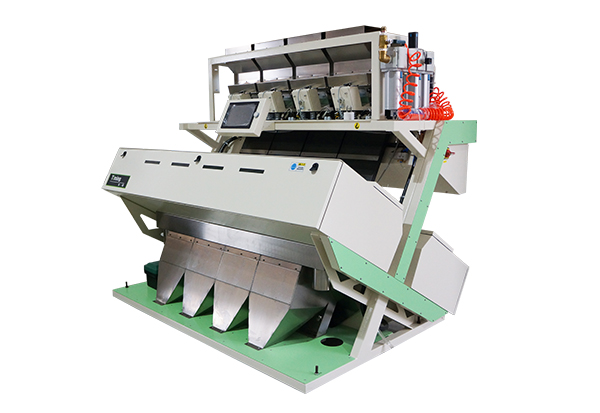When choosing a color sorter for miscellaneous grains, it is necessary to consider factors such as processing needs, types of miscellaneous grains, production capacity, and budget comprehensively, and focus on the following core skills:
1、 Clarify processing requirements and characteristics of miscellaneous grains
Types of miscellaneous grains and impurities
Different grains (such as corn, wheat, soybeans, mung beans, peanuts, etc.) have different particle sizes, shapes, colors, and common impurities (such as mold grains, heterochromatic grains, stones, worm eaten grains). It is necessary to confirm whether the equipment is suitable for the target materials. For example:
Beans (such as mung beans and black beans) have small particles and obvious color contrast, requiring a color sorter with high-resolution cameras and precise recognition capabilities;
Corn, peanuts and other coarse grains with larger particles need to be matched with the width of the equipment channel and the feeding speed to avoid material jamming or omission.
Special impurities such as transparent plastic particles and glass fragments may require near-infrared or multispectral detection functions, which ordinary visible light color sorting machines may not be able to recognize.
Capacity and efficiency requirements
Select machine specifications based on daily processing volume: Small equipment (production capacity ≤ 5 tons/hour) is suitable for small and medium-sized processing households or experimental scenarios; Medium sized equipment (5-20 tons/hour) is suitable for regional processing plants; Large scale equipment (≥ 20 tons/hour) is suitable for large-scale production enterprises.
Pay attention to the difference between "theoretical production capacity" and "actual production capacity": When the impurity content of miscellaneous grains is high, the equipment needs to frequently remove impurities, and the actual production capacity may be lower than the nominal value. It is recommended to refer to the "impurity content capacity" test data provided by the manufacturer.
2、 Comparison of core performance indicators
Recognition accuracy and sorting effect
Sensor configuration: Priority should be given to devices equipped with CCD (Charge Coupled Device) cameras, which typically have a resolution of ≥ 2048 pixels and can recognize color differences of 0.1mm ² or more; Some high-end models use linear CCD or CMOS sensors, combined with multispectral technology (visible light+near-infrared), which can distinguish subtle color differences that are difficult for the human eye to distinguish (such as slight mold spots and internal deteriorated particles).
Exclusion accuracy: High purity requirements (such as export grade miscellaneous grains) require equipment to have a rejection accuracy of ≥ 99%, while ordinary processing can be relaxed to 95% -98%. The manufacturer can be requested to conduct on-site testing and observe the proportion of qualified particles in the rejected material (the false rejection rate should be ≤ 1% -3%).
Sorting speed and processing capacity
High speed equipment can process tens of thousands of particles per second (such as 100000 to 200000 particles per second), suitable for large-scale continuous production; Low speed equipment is suitable for small batches or fine sorting. Attention: Excessive speed may result in insufficient recognition time, affecting accuracy. It is necessary to balance efficiency and precision.
Equipment stability and durability
Core component quality: The brand and lifespan of key components such as vibration feeders, solenoid valves (nozzles), sensors, etc. directly affect equipment stability. For example, imported solenoid valves (such as CKD from Japan and FESTO from Germany) have a fast response time (≤ 10ms) and a service life of over tens of millions of times, while domestically produced low-priced valves may have a shorter service life (millions of times) and require frequent replacement.
Material and process: The channels and troughs that come into contact with miscellaneous grains should be made of food grade stainless steel (such as 304 material) to prevent rusting and contamination of materials; The body structure should be sturdy and not easily deformed under long-term vibration to avoid affecting the sorting accuracy.
3、 Manufacturer strength and service guarantee
R&D and manufacturing capabilities
Priority should be given to professional color sorting machine manufacturers (such as Meiya Optoelectronics, Zhongke Optoelectronics, Taihe Optoelectronics, etc.), whose technical accumulation is deep and their equipment algorithms are more mature for optimizing different grains; Avoid choosing small manufacturers that lack core technology and rely on assembly.
Assessing whether the manufacturer has independently developed image processing algorithms (such as dynamic background subtraction and adaptive threshold adjustment) is the core competitiveness of color selection accuracy.
After sales service and technical support
The color sorter is a precision equipment that requires regular maintenance (such as cleaning sensors, calibrating light sources, and checking solenoid valves). The manufacturer should provide timely on-site maintenance, parts supply, and software upgrade services.
Inquire about the warranty period (usually 1-2 years) and lifetime maintenance costs to avoid equipment obsolescence caused by high accessory prices or technological iterations in the later stages.
Field investigation and case verification
Visit the manufacturer's production workshop and observe the equipment processing technology (such as welding and assembly accuracy); Request to visit the customer's site to inspect the actual operation of the equipment and understand common issues that may arise during long-term use, such as dust accumulation and ease of material cleaning.
For special requirements (such as halal certification, export inspection), it is necessary to confirm whether the equipment has passed relevant certifications (such as ISO9001, HACCP, CE certification, etc.).
4、 Balancing budget and cost-effectiveness
Price range reference
Small single machine: 100000 to 300000 yuan (suitable for workshop style processing);
Medium sized intelligent type: 300000 to 800000 yuan (integrated intelligent algorithm, multi-channel sorting);
Large customized equipment: 1-3 million yuan (applicable to fully automated production lines, supporting multi material switching).
Attention: Low priced devices may shrink in sensors, actuators, and other aspects, resulting in a high failure rate and overall higher costs over long-term use.
Energy consumption and maintenance costs
Equipment power: The power consumption of large equipment is usually 10-30kW, and the electricity cost during production needs to be considered; Some energy-saving equipment adopts frequency conversion control, which can reduce standby energy consumption.
Cost of vulnerable parts: Electromagnetic valves, nozzles, LED light sources, etc. need to be replaced regularly. Inquire about the price and replacement cycle of a single set of accessories, and calculate the annual maintenance cost.
5、 Other practical considerations
Intelligence and operational convenience
Choose devices with touch screen human-machine interface and one click material mode switching to reduce manual debugging time; High end models support AI self-learning function, which can automatically optimize sorting parameters based on real-time material data.
Equipped with fault self diagnosis function (such as sensor abnormal alarm, insufficient air pressure prompt), easy to quickly troubleshoot problems.
Environmental Protection and Safety Design
The operating noise of the equipment should be ≤ 85dB (in accordance with industrial environmental standards) to avoid workshop noise pollution;
Dust emissions must comply with environmental requirements, and some models are equipped with dust removal devices or negative pressure suction systems to reduce dust during the sorting process.
Scalability and upgrade space
If there are plans to expand the types of processing or production capacity in the future, equipment that supports multi-channel sorting (such as 2-4 channels) or modular design can be chosen to facilitate later upgrades of sensors or the addition of sorting units.
Summarize the purchasing process
Clear requirements: List the target types of miscellaneous grains, production capacity, purity requirements, and budget;
Preliminary selection of manufacturers: screen 3-5 reliable suppliers through industry reputation, exhibitions, and online channels;
On site testing: Carry samples to the manufacturer for on-site sorting testing, compare impurity removal rate, misselection rate, production capacity and other data;
Comprehensive evaluation: Based on equipment performance, manufacturer services, price, and long-term costs, select the appropriate model;
Sign a contract: Clearly define the delivery cycle, installation and commissioning, training services, and warranty terms to ensure worry free after-sales service.
By using the above techniques, it is possible to avoid purchasing errors to the greatest extent possible and ensure that the color sorter can achieve efficient and stable sorting effects in the processing of miscellaneous grains.



 Download Center
Download Center Video Center
Video Center (86)0411-87625211
(86)0411-87625211



